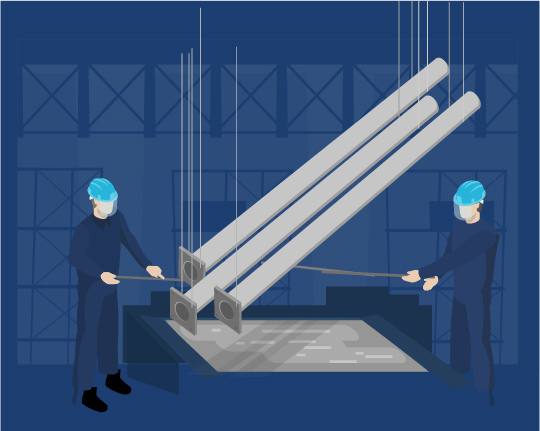What is Galvanisation?
Are you looking to build a Galvanised shed?
Read on if you want to know the value of galvanised columns and galvanised trusses in shed design
Talk to us about galvanisation and structural steel in your sector
Industrial Shed, Hay Shed, Machinery Shed, Dairy Shed, Feedlot Shed, COLA, Packing Shed, Horticulture Shed.
Key points
- Galvanization or galvanizing is a process where molten zinc is applied to steel or iron to protect it from rust or corrosion/oxidation.
- Most common types of galvanizing is Hot Dip galvanizing, Pre-Galvanizing and Electro Galvanizing.
- Both stainless steel and Aluminum are generally a much more expensive option.
Need a Quote?
What Is Galvanization / Galvanizing.
Galvanization or galvanizing is a process where molten zinc is applied to steel or iron to protect it from rust or corrosion/ oxidation. This gives it a silver looking finish which can be typically seen with light poles or beams in a shed or building. Over time this shine will dull but keep a dull silver look.
Typically, galvanisation is used for steel that is exposed to weather or moisture or especially around areas near saltwater where corrosion would happen quickly and aggressively. Not only is it a good rust prevention but it works out a lot cheaper than using metals such as stainless steel or aluminum which can be very costly.
There are 3 common types of galvanizing which are used and the most common types we see are Hot Dip galvanizing and Pre-Galvanizing the less common method is called Electro Galvanizing.
Another Interesting fact about galvanizing is the zinc can react with the base metal if they are put in contact with an electrolyte solution such as saltwater. This is common in areas around beaches. It Causes a reaction called Galvanic Corrosion which acts to protect the base metal. When the reaction occurs the base metal and the zinc form a cathode and an anode. Most of the time depending on the type of metal the zinc has an affinity towards becoming the anode. The anode is the sacrificial layer that acts to protect the cathode or the base metal in this instance.
RECOMMENDED ARTICLE
Cold Formed Sections in Building Industries – Entegra Signature Structures
Hot Dip Galvanizing
Hot Dip Galvanizing is a process in which the base steel (a steel that has a thicker base than the zinc), is manually or chemically cleaned, often both, to remove all rust or oxidation. The raw metal is then fluxed to remove any residual oxidation that may remain, before it is dipped in a motel bath of zinc that sits at a temperature of around 449 °C (840 °F), a bond is formed with the iron and the zinc known as a metallurgical bond. The steel is then taken out and left to cool so it can then be inspected. If the iron was not cleaned or fluxed properly it will be apparent in the inspection stage as the unclean area of the iron will not have a zinc coating, hence making the cleaning phase of the iron highly important.
Pre- Galvanizing
Pre-Galvanizing is one of the most common methods of galvanizing. With this process the steel is taken through rollers through a zinc bath, cut to length and recoiled. It is commonly used for conduit, lip and open channels. This method however offers the least control on quality as when it is cut the edges are left exposed and vulnerable to corrosion and sometimes small patches may be left exposed to corrosion as Pre Galvanizing leaves a thinner layer of zinc compared to that of Hot Dipped Galvanizing and the zinc may not bond to certain areas if the steel isn’t properly cleaned.
 RECOMMENDED ARTICLE
RECOMMENDED ARTICLE
Electro Galvanizing
Electro Galvanizing is a quite different to the previously mentioned methods and is more uniform and has a precise thickness. Electro Galvanizing has a more consistent and smoother finish than opposed to the other methods, however it can tend to be a little thinner than that of Hot Dip, or Pre-Galvanizing which can lead to reduced corrosion protection. This method uses an electric current in an electrolyte solution that electrically reduces positively charged zinc ions that bond with the positively charged base metal. This method is typically used for products that need a neat and smooth finish such as non-exposed car panels, washing machines and exposed painted panels.
Why Use Galvanizing Instead Of Stainless Steel Or Aluminum?
Many ask the question of why use galvanizing when you could just use Aluminum or Stainless steel or any other metal that is slow to corrosion. The answer most of the time is cost. Both stainless steel and Aluminum are generally a much more expensive option that using normal galvanized steel. Another factor is strength, as Aluminum is a far softer metal than that of standard steel which could compromise the strength of certain structures. On the contrary stainless can be difficult to work with but it is far more expensive than getting normal steel galvanized.
Note:
Entegra are offering galvanised columns for Hay Sheds as standard with an optional extra for trusses.
Talk to us about galvanisation and structural steel in your sector
Industrial Shed, Hay Shed, Machinery Shed, Dairy Shed, Feedlot Shed, COLA, Packing Shed, Horticulture Shed.
For more information
1 - 1Share


 RECOMMENDED ARTICLE
RECOMMENDED ARTICLE